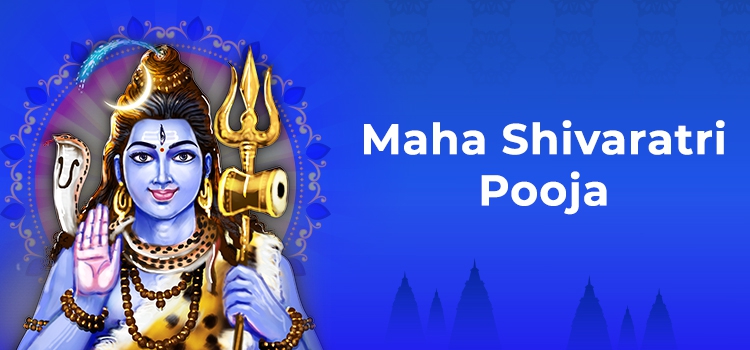Maha Shivaratri and Pooja for Home
Maha Shivaratri festival is dedicated to Shiva. It means ‘the great night of Shiva’. On this day, many Hindus, who are also Shiva devotees, observe a strict fast and a night-long vigil, worshipping Shiva and doing Pooja to him.
Maha Shivaratri night is divided into 4 sections or Praharas. Each lasts 3 hours. In each of the Praharas, devotees perform Pooja. They bathe the Shiva Lingam with many items. The entire night is spent in prayer, worship, and meditation. The fast on the day before is part of the preparation for the Maha Shivaratri rituals.
When one fasts, one can control all the senses and focus on God. It helps one to overcome the rajasic tendencies of one’s mind. And when one stays awake and prays or meditates throughout the night, it helps one to overcome tamasic tendencies. Once Tamas and Rajas are conquered, Sattvik tendencies will be uppermost, and the devotee will be able to focus on the Divine.
Maha Sivaratri night usually begins at 6 pm in most temples. There will be rituals like Pooja, singing kirtans, and doing Japa and Abishekam for the Shiva Lingam. Auspicious items including milk, curd, ghee, honey, coconut water, sugar cane juice, water, etc. This will be accompanied by the chanting of Mantras. The procedure will be repeated at 9 pm, 12 am, and 03:00 am. The ceremonies will conclude at 6 am or dawn. People sing bhajans or read the scriptures in the intervening time between the Poojas and Abishekams.

For those who wish to do Maha Sivaratri Pooja at home, here is a simple procedure.
First, install a Shiva Lingam on a plate or tray.
Perform the Pooja and Abishekam for the Lingam on the plate/tray without any spillage.
You can offer the 5 basic items: Gandham or perfume, Pushpam or flowers, Dhoop or incense, Deepam or Arti, and Neivedya or Prasad. This is known as Paanch Upchar Pooja, which means ‘Pooja with 5 steps or offerings’.
You can also chant a simple one-line Mantra to accompany each offering.
1st Prahara - 6:00 PM
Pooja to Lord Shiva
Offer Gandham/perfume to the Lingam, and utter the prayer:
Om Namah Shivaaya Gandham Samarpayaami.
Offer flowers with the prayer:
Om Namah Shivaaya Pushpam Samarpayaami
Offer incense with the prayer:
Om Namah Shivaaya Dhoopam Samarpayaami
Offer Arti with the prayer:
Om Namah Shivaaya Deepam Samarpayaami
Offer Neivedya with the prayer:
Om Namah Shivaaya Naivedyam Samarpayaami
After these 5 steps, perform Abishekam to the Lingam with milk. Pour the milk slowly and continuously over the Lingam.
While doing so, recite the Mantra: Om Houm Ishaanaaya Namaha.
Then, bathe the Lingam with pure water, chanting the Mantra:
Om Shivaratri Vratam deva Pooja Japa Paraayana Karomi Vidhiwat Datam Grihaan Argyam Maheshwara.
Om Namah Shivaya.
After the Abishekam, use a Japa mala and recite the Panchakshari Mantra, Om Namaha Shivaya, 108 times.
2nd Prahara - 9:00 PM
Repeat the 5-step Pooja as before
Perform Abishekam with curd, chanting the Mantra: Om Houm Aghoraaya Namaha.
Then, bathe the Lingam with water using the above Mantra.
Recite the Panchakshari Mantra again.
3rd Prahara – 12:00 AM
Do the 5-step Pooja.
Perform Abishekam with ghee, chanting the Mantra: Om Houm Vaamadevaaya Namaha.
Bathe the Lingam with water using the above mantra.
Recite the Panchakshari Mantra.
4th Prahara – 3:00 AM
Do the 5-step Pooja.
Perform Abishekam with honey, chanting the Mantra: Om Houm Sadhyo Jaataaya Namaha.
Bathe the Lingam with water as before.
Recite the Panchakshari Mantra.
Complete the ceremony at sunrise or 6:00 am by doing a simple havan and final Arti for the idols and the Lingam.
The Abishekam has to be performed in a particular order: milk, curd, ghee, and, lastly, honey. Milk is the least purified among these items, so it comes first. Curd is made with s little preparation and purification of the milk. Ghee undergoes more purification. Thus, the order of offerings represents the devotee’s gradual but increasing purification as the night progresses. Honey, the final offering, represents the Amrit, the elixir of immortality.
The Puranas talk about the significance of the worship during Maha Shivaratri. A very popular story in the Puranas describes how Goddess Parvati asked Shiva about which was his favorite ceremony among those performed in his honor. Shiva’s reply was his favorite time was the 14th night of Krishna Paksha of Phalgun (Feb-Mar) month, when devotees seek to please him more by mere fasting than by doing Abishekams, etc.
The Legend behind Maha Shivaratri
Once, a hunter named Suswara lived in Varanasi. One evening, he was returning home from the forest with the birds he had killed. But as night fell before he reached home, he decided to spend the night in the forest. He wrapped the dead birds in a cloth bundle and left it at the base of a tree. Fearing attacks by wild animals, he climbed up the tree to spend the rest of the night.
The tree was a Bilva tree - Shiva’s favorite. Also, there was a Lingam at the base of the tree. To avoid falling asleep, Suswara passed the time by plucking the leaves of the tree and dropping them on the Lingam below. The dew also trickled down his body and fell on the Lingam. Thus, the hunter spent the night unconsciously worshipping Shiva. The next day, at dawn, the hunter returned home, completely unaware of the significance of what he had done.
When the hunter died, Yama’s messengers came to take his soul to hell. But Shiva’s messengers had already arrived to take the hunter’s soul to Shiva Loka because of his worship of the Shiva Lingam, even though it was involuntary.
Goddess Parvati was very impressed to hear this story, and she shared it with her friends, and the greatness of Shiva worship on this night became well known in heaven and earth.
Many scriptures have explored the symbolism behind this story. The name, Suswara, indicates good qualities or virtues. He works in the forest, which represents the world. He kills wild animals, symbolizing the destruction of our evil tendencies. He climbs the Bilwa tree, which is a metaphor for spiritual progress. His unconscious worship signifies that every act is an offering to God. He resides in Varanasi, the spiritual center of India and the spiritual eye of wisdom in the human body. Thus, Suswara actually symbolizes the life of a yogi in the world.
Maha Sivaratri 2023 is on Feb 18 (Saturday).




















